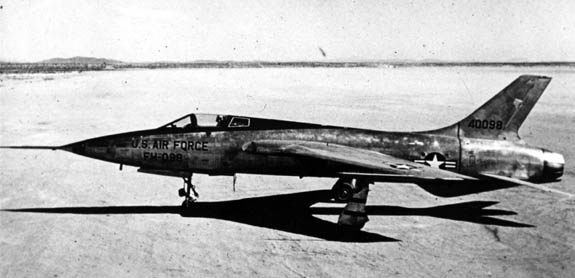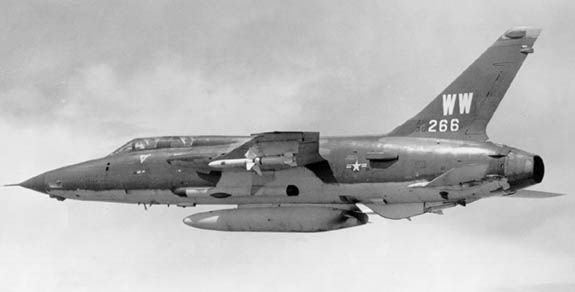WARBIRDS RESOURCE GROUP > VIETNAM > THUD > PREVIOUS PAGE

Republic YF-105A (S/N 54-0098, the first of two prototypes). (U.S. Air Force photo)
As a follow-on to the Mach 1 capable F-100, the F-105 was also armed with missiles and a cannon; however, its design was tailored to high-speed low-altitude penetration carrying a single nuclear bomb internally. First flown in 1955, the Thunderchief entered service in 1958. As the largest single-engined fighter ever employed by the USAF, the single-seat F-105 would be adapted to deliver a greater iron bomb load than the four-engined ten-man strategic bombers of World War II. The F-105 would be best remembered as the primary strike bomber over North Vietnam in the early stages of the Vietnam War. Over 20,000 Thunderchief sorties were flown, with 382 aircraft lost (nearly half of the 833 produced) including 62 operational casualties. Although it lacked the agility of the smaller MiG fighters, USAF F-105s demonstrated the effectiveness of guns, and were credited with downing 27.5 enemy aircraft.
During the war, the two-seat F-105F and F-105G Wild Weasel variants became the first dedicated Suppression of Enemy Air Defenses (SEAD) platforms, fighting against the Soviet-built S-75 Dvina (SA-2 Guideline) surface-to-air missiles. Two Wild Weasel pilots earned the Medal of Honor attacking missile sites, with one shooting down two MiG-17s the same day. The dangerous missions often required them to be the "first in, last out" in order to suppress the threat air defenses prior to strike aircraft arriving and keeping them suppressed until the strike aircraft left the area.

A two-seat F-105G Wild Weasel. (U.S. Air Force photo)
– Design & Development
– Variants
– Specifications
– Operational History
– Gallery
– Survivors
Sources:
Wikipedia: F-105 Thunderchief
WARBIRDS RESOURCE GROUP > VIETNAM > THUD > PREVIOUS PAGE
